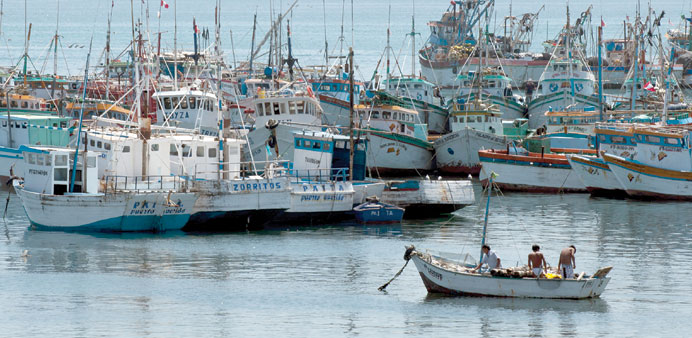ANCHORED: A file photo of fishing boats anchored in Paita, Peru. The warmer waters last year ensured a huge drop in the volume of cold-water anchovies that were caught by the coast. Peru is the world’s top producer of animal feed made of ground-up anchovy, known as fishmeal, and the lack of anchovies is one of the reasons that economic growth slowed to its weakest pace in five years. Photo: US Navy/Wikipedia
By Steff Gaulter
At the beginning of July, the Peruvian government declared a 60-day state of emergency. This wasn’t for a catastrophe that had already happened, but was in case a natural disaster happened in the very near future.
The reason that Peru is on high alert is that El Nino has developed in the Pacific Ocean. El Nino is the slight warming of the waters in the Pacific Ocean and is known to affect the weather around the world. Peru is one of the countries that is often struck by flooding during an El Nino event, so this time the government has pre-empted a disaster and is warning people of an imminent threat.
El Nino is triggered by a change in wind speed across the Pacific. The prevailing winds usually flow from east to west, which pushes the warm surface waters of the tropical Pacific Ocean towards Indonesia. This allows cool water to well up around the coast of South America. The cool water is rich in nutrients and fish, providing rich pickings for the Peruvian fishing industry.
During an El Nino year, however, the winds, which blow along the surface of the tropical Pacific Ocean, ease. Why this happens is unclear, but it can have dramatic effects. The warm water sloshes back towards South America, which hides the nutrient-rich cold waters and ensures fish are in short supply.
The lack of fish is the reason that El Nino was first discovered by the Peruvian fishermen. They noticed that every three to seven years, there would be virtually no fish in the seas. The reduction in fish caused by El Nino can be dramatic; an event in 1972-1973 almost brought the complete collapse of the Peruvian fishing industry.
The slackening of the winds in an El Nino event also ensures that the warm waters are not blown as far west as usual. This means the waters around Indonesia are cooler than usual and there are less showers in Indonesia as a result. Peru and Indonesia are directly affected by El Nino, but there are plenty of other locations much further afield which also notice a change in their weather. Other parts of southeast Asia and eastern Australia are prone to drought during an El Nino year, as are South Africa and northeast Brazil. Meanwhile the southern states of the USA and parts of South America are often hit by flooding.
The change in water temperature of the Pacific Ocean during El Nino is usually less than 1.5C. This may sound fairly insignificant, but even this slight change can have a dramatic impact on the weather. However, no two El Nino events are the same and an El Nino event cannot be guaranteed to bring flooding to Peru or drought to South Africa. All we can say is that these events are more likely, and the stronger the temperature change, the greater the chance.
The strongest El Niño event that has ever been recorded occurred in 1997-1998, and its impact was widespread. Indonesia, which is often hit by droughts during El Nino, was gripped by a particularly severe one. The lack of rain meant that there was a huge shortfall in crops, particularly rice. In turn, the drought triggered wildfires that burned vast swathes of the rainforest, endangering many animals. The smoke from the fires affected Brunei, Malaysia and Singapore. Transport, tourism and the public’s health were all badly affected.
The year 1997 also brought severe flooding to Peru. The rains kept falling and the rivers kept rising. Eventually many overflowed, generating flash floods that smashed through everything in their paths, sweeping away people and livestock. The standing water ensured mosquitos thrived, which triggered a severe outbreak of malaria. Flood water poured into the coastal Sechura Desert, which for the previous fifteen years had been as dry as a bone. By 1998 part of the desert was transformed into the second largest lake in Peru, stretching a staggering distance of 145 kilometres (90 miles).
The current El Nino event has been simmering for about a year now. Last year there was a slight warming of Peru’s coastal waters; not enough to be classed as El Nino, but enough to impact the fishing industry. The warmer waters ensured a huge drop in the volume of cold-water anchovies that were caught by the coast. Peru is the world’s top producer of animal feed made of ground-up anchovy, known as fishmeal, and the lack of anchovies is one of the reasons that economic growth slowed to its weakest pace in five years.
The temperature change in the Pacific is now pronounced enough to be officially classed as El Nino and the conditions are expected to continue through the winter and into the spring of 2016. As it becomes stronger, the impacts are likely to be felt more acutely around the globe. Those parts of the world that often experience natural disasters during El Nino are watching nervously to see what happens. As we can tell from the actions of the government in Peru, it’s certainly something that is to be taken seriously.

